Removing excess heat is a normal function of the human body. This is accomplished by pumping blood close to the skin’s surface, which causes the release of sweat. This usually works, until warmer, humid weather makes it a little harder to do so. When the air becomes warm and moist, the air will absorb a lot less sweat from the skin. It will also hinder the human body’s capability to cool itself down by sweating.
When we become dehydrated, it means our bodies are lacking water and electrolytes, which are vital salts. Dehydration lessens our sweating capabilities. If we are not able to cool ourselves through sweating, we might experience heat exhaustion. Heat exhaustion will raise the body’s temperature.
In the hot seasons, millions of people are exposed to the dangerously high temperatures every year. Laborers who work outside make up the biggest segment of patients who seek medical treatment for heat-related illness. The next largest segments of those who are often affected by heat-related illnesses include the elderly, young children and athletes. Heat-related illnesses are almost entirely preventable. Doctors can do a lot to educate their patients on how to remain safe during the hot months.
What is Heat Stress?
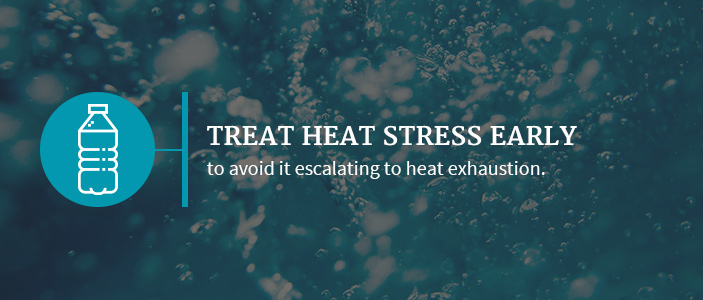
Sometimes, human bodies become so hot that they cannot regulate body heat adequately. According to OSHA (Occupational Safety and Health Administration), if this occurs, the body’s internal temperature starts to go up over the standard 98.6 degrees Fahrenheit. The rising temperature strains the body. This is heat stress. Heat stress symptoms are classified into levels of heat-related illnesses, or HRIs. Each category depends on the HRI’s severity.
Treat heat stress early to avoid it escalating to heat exhaustion. Heat stress, if ignored, will escalate quickly to heat exhaustion, and then into the more severe territory of heat stroke.
It is crucial to your well-being to be aware of how you feel if you’re outside in the sun. Be sure to consider your symptoms. If applicable, evaluate the symptoms of the people around you. Prompt medical attention can ward off heat exhaustion and its damage. Untreated heat stroke can cause damage to organs, your brain and other tissues.
Symptoms of Heat Exhaustion
Heat exhaustion symptoms vary. They could include sweating excessively, headaches and dizziness. Overlooking these symptoms is a little too easy sometimes, as they can mimic those of several other medical conditions.
Common signs of heat exhaustion to look for:
- Excessive sweating
- Headache
- Dizziness
- Nausea
- Vomiting
- Increased internal body temperature
- Rapid or weak pulse
- Low blood pressure
- Lightheadedness upon standing up or bending over
- Muscle cramps or weakness
- Pale, cold skin, possibly damp
- Goosebumps
- Aggressive or irritable behavior
- Reddish, flushed face
- Shallow, rapid breathing
Causes of Heat Exhaustion and Other Contributing Factors
Warm, humid weather combined with demanding, outdoor labor often are the culprits of heat exhaustion. Other factors can increase the likelihood of heat exhaustion.
- 60 percent or higher atmospheric humidity level
- Conditions of the kidney or liver
- Intense physical labor
- Diabetes, hyperglycemia or other conditions that increase the chances of being dehydrated
- Drug abuse
- Alcohol use, long-term or heavy
- Smoking
- Being obese over overweight
- Medications for depression, insomnia or poor circulation
- Hypertension or high blood pressure
- Cardiovascular or heart disease
- Being younger than 4 years old or older than 65 years old
The factors that will put a child at risk for dehydration are the same things that will put an adult at risk for dehydration: extended exposure to the direct summer sun, elevated humidity levels and high temperatures without drinking enough fluids or getting enough rest.
Complications Caused by Heat Exhaustion
On its own, heat exhaustion is not painted as a serious health concern. However, if it is left untreated, heat exhaustion may escalate to heat stroke, which has severe complications. These include organ failure and brain damage. Heat exhaustion can cause a serious health risk when intense physical activity is continued without addressing symptoms. Complications of heat exhaustion may include:
- Serious injury to kidneys
- Rhabdomyolysis, the breakdown of muscle fibers which may lead to kidney failure, dark urine, vomiting and muscle aches
- Liver failure
- Arrhythmias, an uneven or overly fast or slow heartbeat
- Coma or delirium
How To Prevent Heat Exhaustion — Can It Be Avoided?
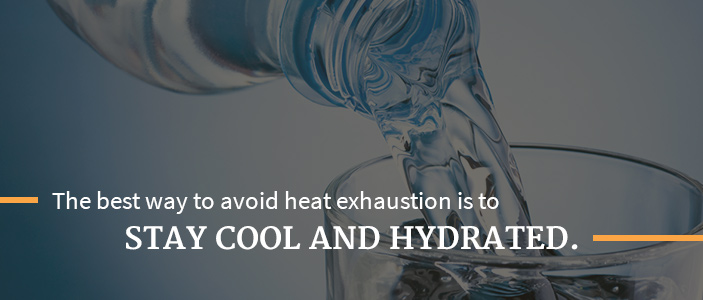
There are several ways to avoid heat illnesses. Here are some very useful tips for how to combat heat exhaustion. Keep them in mind.
The best way to avoid heat exhaustion is to stay cool and hydrated. If possible, stay inside in air-conditioned areas when the temperature is high. If you have to go outside, take precautions, such as the following:
- Wear light-colored, lightweight, loose-fitting clothing. Light colors reflect heat and sunlight and absorb less heat than dark colors.
- Wear a large-brimmed hat or use an umbrella to protect yourself from the sun.
- Apply sunscreen with an SPF of 15 or higher.
- Drink water often during daylight hours to avoid dehydration.
- Sports drinks like Powerade and Gatorade can assist in restoring electrolytes if necessary.
- Avoid caffeinated drinks such as coffee, tea and soda, as well as alcohol.
- Outdoor activities should be rescheduled for cooler times of the day. Usually, this is before 10 AM and after 6 PM.
- Take several breaks from outdoor activities taking place in heat and humidity.
- Never leave a child, a pet or yourself in a car when it is hot. Even if windows are open, the heat can become severe and dangerous rapidly.
How Do We Treat Heat Exhaustion?
There are some things you need to do if you suspect someone has a heat-related illness. The following tips on how to cure heat exhaustion symptoms should be very useful in trying to prevent heat exhaustion from escalating into heat stroke.
- Quickly get out of the heat and into a cool place. If air conditioning is not available, at least get into the shade.
- Lay down, elevate your legs and feet so that blood will start flowing to your heart.
- Remove any tight or extra clothing.
- Soak some towels in cold water and apply them to your skin.
- Take a cool bath or, if you are strong enough to stand up, a cool shower.
- Sip, do not chug, water or sports drinks. Do not drink caffeinated or alcoholic beverages.
Remember to Protect the Vulnerable From Heat Illness
The most vulnerable to heat illnesses are the elderly, children, and babies. They are a lot more sensitive to heat and should be afforded more attention than usual in the hot months. Older people do not adjust to abrupt changes in temperature as well as they did when they were younger. They have a higher chance of having a chronic condition that affects how their bodies respond to heat or of being on medication that decreases their ability to control their core temperature or their ability to sweat.
If you have elderly neighbors, friends or relatives, you can help protect them from heat-related illnesses by doing the following:
- Keep them in mind. Visit elderly adults who are at risk at least twice a day. Check for signs of heat exhaustion or heat illness.
- Be sure to encourage your elderly friends and relatives to drink more fluids such as water and other cool, alcohol-free beverages. Do this even if they aren’t particularly active or athletic.
- Important note: If their medical professional has limited the amount of liquid they drink, or if they are on diuretics, they will need to consult with their doctor to see how much they should drink if the weather becomes hot.
- If they do not have air conditioning where they live, bring them to an air-conditioned location such as a cooling center if they have issues with transportation.
Protect Children From Heat Exhaustion
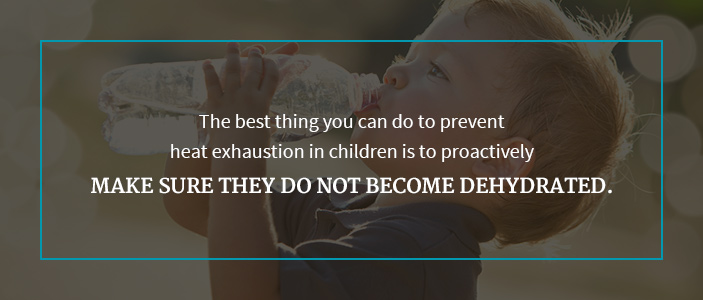
The long summer days are filled with activities for kids. From camps to organized sports, kids are outside a lot. Even spending days at the local pool can increase a child’s risk for heat illness. Children are at higher risk for heat exhaustion than adults because their bodies have less surface area compared to their weight. This makes it more difficult for heat to leave their skin. The best thing you can do to prevent heat exhaustion in children is to proactively make sure they do not become dehydrated.
First and foremost, make sure they drink early and often. Cold water is the best option. When your child goes to play, send them to their activities fully hydrated. While they are playing, see that they take periodic breaks to drink something, even if they claim they aren’t thirsty. An appropriate size drink for a child is about five ounces if a child weighs 88 pounds.
Signs of dehydration in children are similar to those of adults. Look for tiredness, low energy and dry lips. If a child says he or she is thirsty, they are most likely already dehydrated. Get them to sip water or a sports drink immediately. If your child becomes heat exhausted, immediately stop their play, bring them into a cool or shady area, and treat them with the same tips listed earlier used for adults.
What is Heat Stroke?
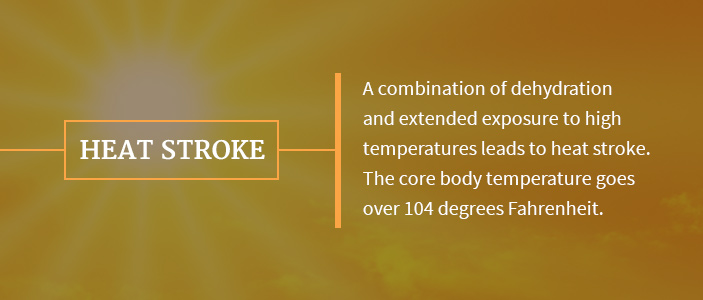
Heat stroke is the most severe heat illness. Heat-related illness is classified as heat stroke when the core body temperature is over 104 degrees Fahrenheit. If you think someone has heat stroke, immediately call 911 or get them to a hospital. In the meantime, treat their symptoms the best you can.
Heat stroke can damage brain cells and other internal organs. It mostly affects people over the age of 50, but has also sickened young athletes who are otherwise fit and healthy.
Escalation from heat exhaustion is usually how heat stroke or sunstroke develops. It often starts with a mild heat-related illness like heat stress and escalates to heat exhaustion. What is most worrisome is that heat stroke can often present itself suddenly with no previous signs of heat illness at all.
A combination of dehydration and extended exposure to high temperatures leads to heat stroke. It can lead to the body’s temperature regulation system failing. Above 104 degrees Fahrenheit, the nervous system develops complications after being exposed to this very high temperature.
Symptoms of Heat Stroke
Fainting is usually the first sign of heat stroke.
Other heat stroke symptoms include:
- A headache that throbs
- Light-headedness and dizziness
- Not sweating even in hot weather
- Dry, hot, reddish skin
- Cramps or muscle weakness
- Nausea
- Vomiting
- Rapid heartbeat
- Shallow, rapid breathing
- Confusion or disorientation
- Seizures
- Unconsciousness
Risk Factors for Heat Stroke
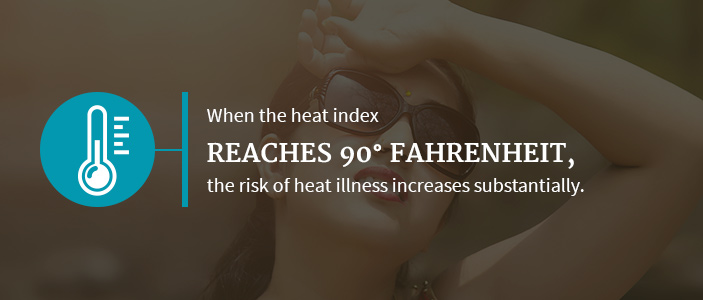
Older adults whose homes lack air conditioning or proper ventilation are most likely to be affected by heat stroke. Other people who are at high risk of heat stroke include those in any age group who do not drink enough fluids, who have chronic ailments or who drink too much alcohol.
The heat index is strongly linked to heat stroke risk. The heat index measures how hot it feels when relative humidity and temperature are calculated together. Remember, a humidity level of sixty percent or higher hinders the evaporation of sweat, which diminishes your body’s ability to cool off.
When the heat index reaches 90 degrees Fahrenheit, the risk of heat illness increases substantially. This is why it is so important to take note of the daily heat index and to note that being in full summer sun increases the reported index by up to fifteen degrees.
Other risk factors for heat stroke include:
1. Age
Again, children under 4 and adults over 65 are slower to adjust to heat than other people.
2. Health issues
Many health conditions increase your risk of heat stroke, including:
- Being obese or underweight
- Having diabetes
- Having hypertension or other heart diseases
- Having respiratory or kidney disease
- Having a mental illness or mood disorder
- Abusing alcohol
- Having a condition that causes fever
3. Medication:
These medications can increase the risk of developing heat stroke:
- Antihistamines
- Diet Pills
- Diuretics, sometimes called water pills
- Sedatives
- Stimulants
- Seizure medications or anticonvulsants
- Heart and blood pressure medications
- Antidepressants or antipsychotics
- Illegal drugs like cocaine and methamphetamine
Preventing Heat Stroke
The steps to prevent heat stroke are similar to the prevention steps for heat exhaustion. Mainly, stay hydrated, wear loose, light-colored clothing, try to avoid arduous physical activity in direct sunlight, and take note of the heat index for the day.
When Should You See a Doctor?
Left untreated, heat exhaustion can lead to heat stroke. Heat exhaustion does not affect and impair mental function, cause loss of consciousness, or confusion. Heat exhaustion will not cause a person’s body temperature to go over 103 degrees Fahrenheit. If a person faints or loses consciousness, has a temperature over 104 degrees Fahrenheit, is experiencing extreme nausea, vomiting, seizures, or any of the listed heat stroke symptoms, immediately seek medical assistance for that person.
Get the Information You Need
For more information on how to safely navigate your summer, check out our other articles. The Orthopedic Institute of Pennsylvania is dedicated to providing exceptional care to our patients. We offer a holistic approach to all your orthopedic issues, and many of our providers are specialists in case you need more specialized care. We have a variety of services and treatments and are proud to say 95 percent of our patients never need orthopedic surgery to cure their problems. Request an appointment today at one of our eight convenient locations.


